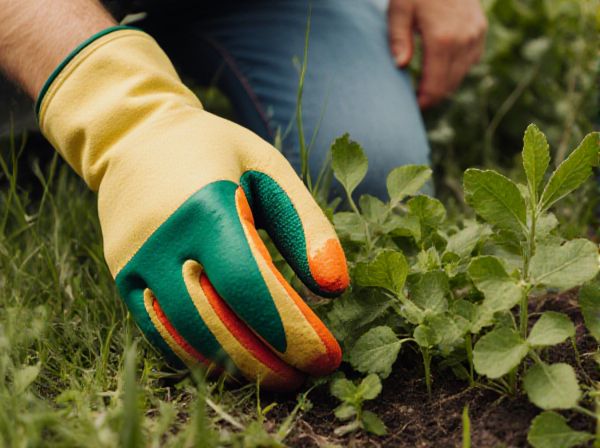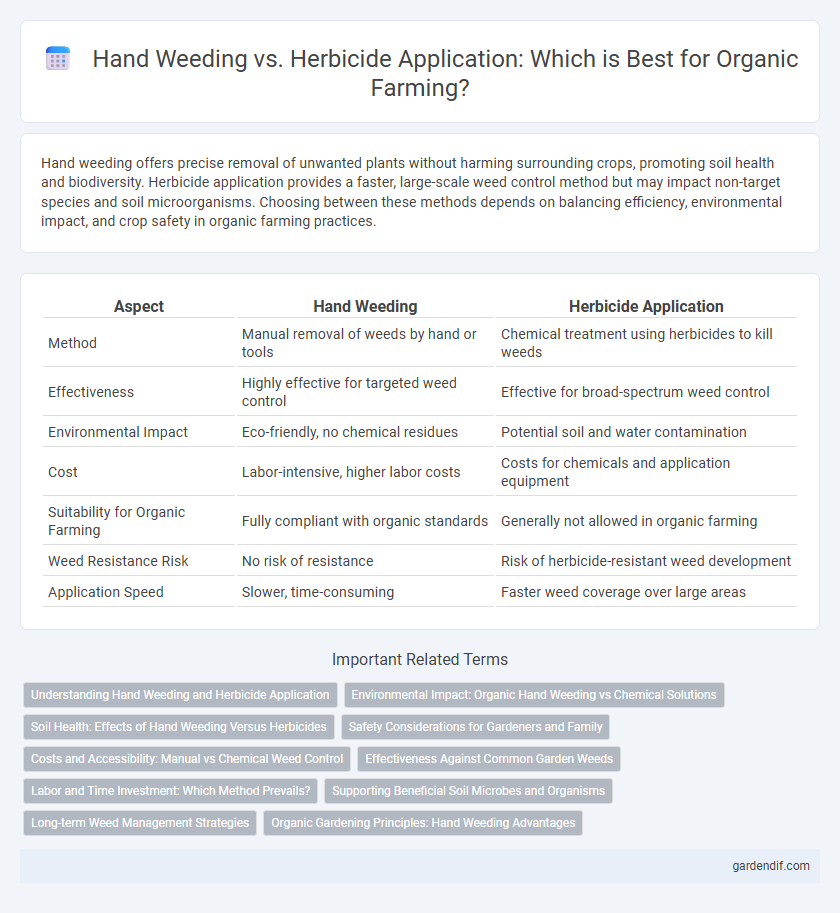
Hand weeding vs herbicide application Illustration
Hand weeding offers precise removal of unwanted plants without harming surrounding crops, promoting soil health and biodiversity. Herbicide application provides a faster, large-scale weed control method but may impact non-target species and soil microorganisms. Choosing between these methods depends on balancing efficiency, environmental impact, and crop safety in organic farming practices.
Table of Comparison
| Aspect | Hand Weeding | Herbicide Application |
|---|---|---|
| Method | Manual removal of weeds by hand or tools | Chemical treatment using herbicides to kill weeds |
| Effectiveness | Highly effective for targeted weed control | Effective for broad-spectrum weed control |
| Environmental Impact | Eco-friendly, no chemical residues | Potential soil and water contamination |
| Cost | Labor-intensive, higher labor costs | Costs for chemicals and application equipment |
| Suitability for Organic Farming | Fully compliant with organic standards | Generally not allowed in organic farming |
| Weed Resistance Risk | No risk of resistance | Risk of herbicide-resistant weed development |
| Application Speed | Slower, time-consuming | Faster weed coverage over large areas |
Understanding Hand Weeding and Herbicide Application
Hand weeding involves manually removing weeds from crops, offering precise control without chemical residues, ideal for organic farming systems prioritizing soil health and biodiversity. Herbicide application uses chemical agents to suppress or eliminate unwanted plants, providing rapid weed control but potentially impacting soil microflora and non-target species. Understanding these methods aids in balancing effective weed management with environmental sustainability and crop yield optimization.
Environmental Impact: Organic Hand Weeding vs Chemical Solutions
Hand weeding in organic farming minimizes soil and water contamination, preserving biodiversity by avoiding chemical residues harmful to beneficial insects and microorganisms. Herbicide application often leads to soil degradation, water pollution, and negative effects on non-target species, causing long-term environmental damage. Organic hand weeding promotes sustainable agricultural ecosystems by maintaining natural soil health and reducing chemical dependency.
Soil Health: Effects of Hand Weeding Versus Herbicides
Hand weeding preserves soil structure by avoiding chemical disturbances, promoting beneficial microbial activity and enhancing nutrient cycling. Herbicide application can disrupt soil microbial communities and reduce biodiversity, potentially leading to long-term soil degradation. Maintaining soil health through hand weeding supports sustainable organic farming practices and improves soil resilience.
Safety Considerations for Gardeners and Family
Hand weeding in organic gardening eliminates exposure to toxic chemicals, ensuring a safer environment for both gardeners and their families. Unlike herbicide application, hand weeding reduces health risks associated with chemical residues, such as skin irritation and respiratory issues. Choosing manual weed control promotes long-term safety and minimizes environmental impact, supporting a healthier home and garden ecosystem.
Costs and Accessibility: Manual vs Chemical Weed Control
Hand weeding in organic farming incurs higher labor costs due to intensive manual effort but offers precise weed removal without chemical inputs. Herbicide application lowers labor expenses and is faster, yet chemical costs and potential environmental restrictions may limit accessibility for some farmers. Organic growers often balance these factors by choosing manual weeding to meet certification standards while managing budget constraints.
Effectiveness Against Common Garden Weeds
Hand weeding offers precise control by physically removing weeds like dandelions and crabgrass without risking chemical resistance, making it highly effective for small gardens. Herbicide application efficiently targets broadleaf and grassy weeds across larger areas but may require repeated treatments to manage resistant species such as pigweed and lambsquarters. Combining hand weeding with selective herbicide use enhances overall weed management in organic gardening, reducing soil disturbance and chemical impact.
Labor and Time Investment: Which Method Prevails?
Hand weeding requires significant labor and time investment, often demanding multiple hours per acre depending on weed density and crop type. Herbicide application significantly reduces labor hours, allowing for faster coverage and less physical strain, but raises concerns about chemical use and environmental impact. Organic growers prioritize hand weeding due to its compatibility with sustainable practices, despite its higher labor intensity and time requirements compared to herbicide use.
Supporting Beneficial Soil Microbes and Organisms
Hand weeding preserves beneficial soil microbes and organisms by avoiding chemical disruption, maintaining a healthy and balanced soil ecosystem. Herbicide application can negatively impact microbial diversity and reduce the activity of essential soil fauna critical for nutrient cycling and plant health. Supporting beneficial soil biology enhances organic matter decomposition, nutrient availability, and long-term soil fertility.
Long-term Weed Management Strategies
Hand weeding offers precise removal of weeds without chemical residues, promoting soil health and biodiversity essential for sustainable organic farming. Herbicide application, while effective for immediate weed control, can disrupt beneficial soil microorganisms and lead to resistant weed populations over time. Integrating manual weeding with cultural practices such as crop rotation and cover cropping ensures robust, long-term weed management in organic systems.
Organic Gardening Principles: Hand Weeding Advantages
Hand weeding aligns with organic gardening principles by promoting soil health and biodiversity through non-chemical weed control. This method prevents herbicide runoff and toxin accumulation, preserving beneficial microorganisms and earthworms essential for nutrient cycling. Manual removal also enables targeted weed management, reducing competition without disrupting the garden ecosystem.
Hand weeding vs herbicide application Infographic

 gardendif.com
gardendif.com